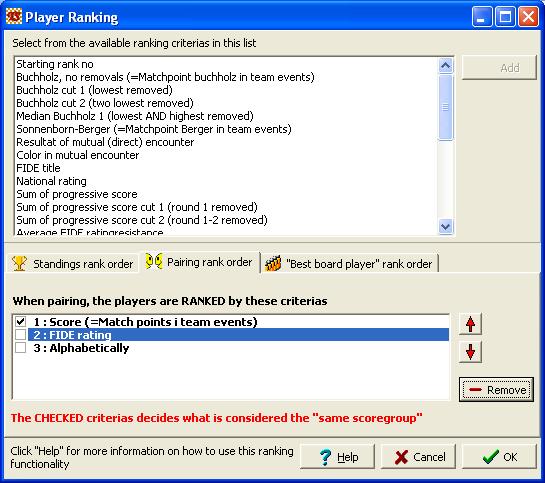
The players are sorted by rank in two cases: When calculating the standings, and when preparing for a pairing procedure.

Using this function you are in total control as to how the players are to be ranked. - that is, which criterias to use, and i what order, when sorting the standings report.
When you create a new tournament, TournamentService automatically will select a default set of ranking criterias, according to the most common rules for the pairing system chosen. In the example to the right, we can see the three criterias which TournamentService will assign in a standarg Swiss(lim) tournament according to the FIDE handbook C04.1F point 10.
As we can see on line 1, Score is chosen as the most important criteria (quite common!). Line 2 says that if two players have equal score, Result of mutual encounter is used to differentiate the players. If they still cannot be separated, Line 3 says Average FIDE ratingresistance is next to separate them. Only if all these criterias are equal, they will share the place on the standings report..
If you wish, you may change these default criteria, their order, or add more criterias. The dialog to the right is opened from "Options" - Tournament options, by clicking the "Ranking" button. The idea is to fill in the lower list as needed by selecting from the upper. You can also change the order in which the criterias are applied by using the arrow buttons.
Which criterias are available depends if this is a team- or individual tournament..

The Monrad, Konrad and Swiss pairing systems also has a different ranking order, used during pairing. Before pairing a new round, the players are sorted according to specific criterias which usually are different from the standings. The example to the right shows the ranking most commonly used in swiss tournaments.
The usage is similar to the ranking, see the previous paragraph. However, in this case you must also be clear as to which cirterias are checked and which are only included in the list.
When pairin, the players are always orderes by all the criterias in this list. In contrast, the checked criterias defines what is considered the ”same scoregroup”.
So, in the shown team event example, what we have told TournamentService, is that:
1) Only the checked Match points decides which score grroup a team belongs to (because this is the only checked criteria in the list)
2) Within the score groups, the teams are ordered by their average FIDE rating.
3) If two teams has the same fide rating also, they are ordered alphabetically before the pairing starts
This is similar to "Standings rank order", but is used in the report "standings per board", which is an individual ranking withing each board in team tournaments.